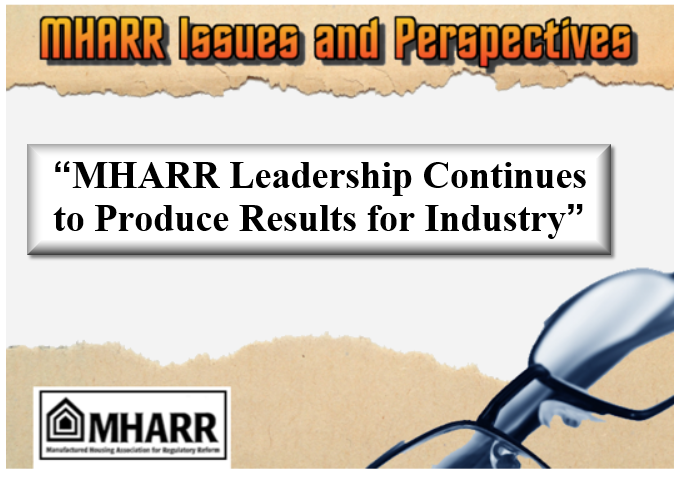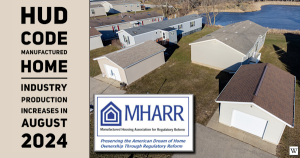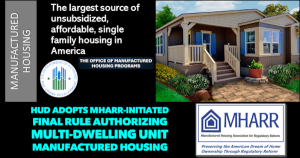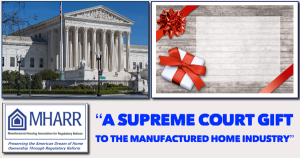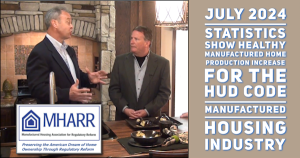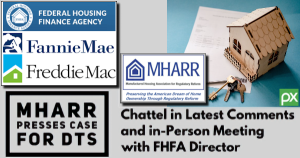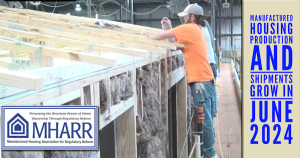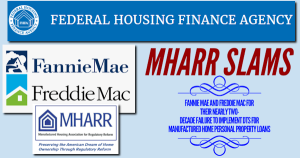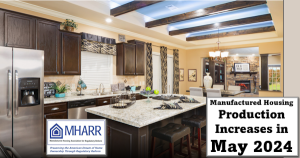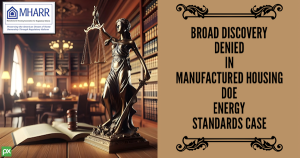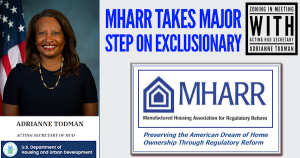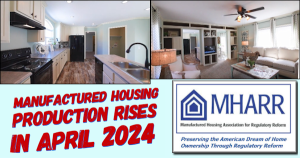[vc_row][vc_column][vc_column_text]MHARR, as an organization, has always been tasked with being a leader on the issues it addresses. Established by industry pioneers in 1985, MHARR was not designed, and was never intended to be, a status quo organization given to complacency, pulling punches, or “going along” with regulators, industry detractors, or anyone else. It was formed, instead, to be an aggressive fighting force on behalf of manufactured housing industry businesses.
MHARR’s primary “objective,” from day-one, as its Charter attests, has been to “oppose abusive [regulatory] practices.” In pursuing this mission, MHARR’s principal focus has always been the federal manufactured housing regulatory program. But the HUD program is not, and never has been, MHARR’s sole focus, as government activity (or inactivity) in other areas, such as consumer financing, placement and development issues, and others, have had – and continue to have – a significant (negative) impact on the industry and especially its smaller businesses.
While the fight to protect, defend and advance the HUD Code industry took a major step forward with the enactment of the landmark Manufactured Housing Improvement Act of 2000, the years that followed, and particularly the eight years of the Obama Administration, were difficult, as HUD was able – sometimes with the tacit support of some in the industry – to evade, distort, or ignore major statutory reforms, including: (1) the requirement for an appointed, non-career program administrator; (2) mandatory Manufactured Housing Consensus Committee (MHCC) review of all proposed standards, regulations, interpretations and other changes to HUD policies, procedures and practices; (3) the requirement for “separate and independent” contractors; (4) limitations on the scope and nature of “monitoring;” (5) enhanced federal preemption; and (6) the absence of full and fair competition for program contracts, as exemplified by the 40-year-plus program “monitoring” contractor, among other things.
Very early in 2016, however, and well prior to the election of President Trump, MHARR began to recognize – based on painstaking evaluation and analysis of the President’s specific campaign positions – that there would be an unprecedented opportunity under a Trump Administration to change the focus, direction and leadership of the federal manufactured housing program based on the letter and intent of the 2000 reform law, to stop excessive or unreasonable regulations (and regulatory “interpretations”), and to roll-back other aspects of federal regulation that needlessly increase the cost of manufactured housing while doing little or nothing for consumers. Now, slightly more than a year later, with the 2016 election having made MHARR’s recognition of this opportunity and its corresponding plan of action a reality, the results of that plan of action can be assessed.
OBJECTIVE: REASSIGN AND REPLACE HUD PROGRAM ADMINISTRATOR
MHARR, immediately upon the election of president Trump – and alone within the industry – publicly called for the re-assignment and replacement of HUD manufactured housing program administrator Pamela Danner. In a December 1, 2016 communication to Vice President-Elect Pence (heading the Administration’s transition team), MHARR formally sought the reassignment of Ms. Danner and the appointment of a new non-career program administrator. MHARR explained at the time, “[T]he appointment of a non-career manufactured housing program administrator – in accordance with the 2000 reform law and, just as importantly, the policy perspectives of the President-Elect — is essential to revitalize this program, ensure the full and proper implementation of the 2000 reform law, and re-energize an industry which has suffered unprecedented production declines over the past decade-plus.”
MHARR reiterated the urgent need – and necessity for – the appointment of a new, non-career program administrator once again on December 6, 2016, and subsequently raised this matter in every interaction it had with Trump Administration officials at HUD. Others in the industry, by contrast, were publicly silent on this desperately-needed change through most of 2017.
As a result of MHARR’s public leadership on this matter from the outset, the prior manufactured housing program administrator, as announced by HUD in late 2017, was re-assigned within the HUD Office of Single-Family Housing, and replaced on an interim basis by the program’s Deputy Administrator, with further action pending on a permanent replacement. While this initial result is consistent with MHARR’s goals, it could have been achieved much earlier if MHARR’s public call for a new administrator had been supported by the rest of the industry. Nevertheless, as this process plays-out, MHARR will continue to seek the appointment of a qualified and appropriate non-career program administrator.
OBJECTIVE: FREEZE, REVIEW AND REFORM HUD REGULATIONS
The day after the 2016 election, MHARR publicly called for a new approach to HUD regulation, stating: “A fresh approach to unnecessary and needlessly-costly federal manufactured housing regulation along the lines stated by the president-elect, requiring legitimate, ground-up evidence to support any new – or existing regulation – showing both the need for regulation and real benefits for consumers … rather than wasteful and unnecessary make-work for entrenched contractors, would have a tremendously positive impact on the manufactured housing industry and the Americans who rely on manufactured housing….” (Emphasis in original). A week later, in a November 18, 2016 communication to HUD, MHARR called for an immediate freeze on all pending HUD manufactured housing regulations including, most particularly, its proposed “Frost-Free” Installation Interpretive Bulletin (IB), based on a November 15, 2016 notice from Congress calling on all federal agencies to defer any activity to “finaliz[e] pending rules or regulations.”
Subsequently, less than one month after the election, and anticipating the regulatory reform initiatives set forth in Executive Orders issued after President Trump’s inauguration, MHARR targeted specific HUD regulatory and program changes that it would advance on a priority basis, including: (1) major changes to the “on-site” construction rule; (2) withdrawal of the baseless and costly “frost-free” foundation Interpretive Bulletin; (3) retraction of HUD’s effort to compel states to alter state-law installation standards; (4) withdrawal of HUD’s program of expanded in-plant enforcement; (5) full implementation of enhanced federal preemption under the 2000 reform law; (6) ensuring full and proper funding of State Administrative Agencies (SAAs); (7) restoring collective industry representation on the MHCC; and (8) termination of HUD’s 40-year-plus dependence on the same revenue-driven enforcement contractor, and replacement of the current de facto sole-source program contracting system with one based on full and fair competition.
Again, these priorities were stressed in all subsequent MHARR communications, contacts and meetings with new Trump Administration officials at HUD, culminating, ultimately, in a full regulatory freeze. This was followed, on May 15, 2017, by a departmental-level regulatory review of all existing and pending regulations and “regulatory actions” under Trump Administration Executive Orders (EOs) 13771 (“Reducing Regulation and Controlling Regulatory Costs”) and 13777 (“Enforcing the Regulatory Reform Agenda”). Based on its post-election strategy, MHARR filed comprehensive comments in this proceeding, seeking fundamental change within the HUD program, including, among other things, the modification or withdrawal of specific existing and pending regulations, pseudo-regulatory actions and regulatory “interpretations;” the re-assignment and replacement of the then-program administrator; and fundamental reform of all program contracting procedures.
MHARR reasserted and expanded-on all of these points when HUD, on January 26, 2018, announced a program-specific, “top-to-bottom” review of all existing and pending manufactured housing regulations and “regulatory actions” (which had been sought by MHARR since early 2017). MHARR filed comprehensive comments in this proceeding on February 20, 2018, and strongly reiterated the need for fundamental program reform in a January 29, 2018 face-to-face meeting with HUD Secretary, Dr. Benjamin Carson.
Here again, while others in the industry have made a show of embracing “regulatory reform” after decades of “going-along-to-get-along” with HUD (and other) regulators, aggressive advocacy for regulatory reform has always been MHARR’s primary focus. And with an Administration now in office that has pledged to “deconstruct the regulatory state,” the time has never been better to pursue and achieve fundamental change. With the results of HUD’s EO 13771/13777 manufactured housing program regulatory review still outstanding, MHARR will continue to aggressively seek the fundamental reform that is essential for strong industry growth and production levels in the hundreds-of-thousands of homes annually.
OBJECTIVE: WITHDRAWAL OF THE PROPOSED DOE “ENERGY” RULE
Unlike other manufactured housing industry organizations, MHARR has opposed the manufactured housing “energy” rule proposed by the U.S. Department of Energy (DOE) on June 17, 2016 from its inception. MHARR cast the only “no” vote against the proposed rule during the supposed “negotiated rulemaking” process conducted by DOE (but instigated, encouraged and advanced by others in the industry) in 2014 and 2015, and in August 8, 2016 written comments, exposed both that “process” and DOE’s alleged “cost-benefit” analysis to be a baseless sham, contrived to support a pre-ordained result.
Following the election of President Trump, MHARR immediately expanded its aggressive fight against this proposed rule that would needlessly add $6,000.00 or more to the retail cost of a new manufactured home. Ten days after the election, MHARR called on DOE to defer further action on the proposed rule based on Congress’ November 15, 2016 regulatory moratorium request to federal agencies. Later, in July 14, 2017 written comments submitted to DOE as part of DOE’s EO 13771/13777 regulatory review process, MHARR reiterated its call for the withdrawal of the proposed rule based on all of its previous arguments, as well as the Trump Administration’s withdrawal from the 2016 “Paris Climate Accord,” which formed the specific basis for the June 17, 2016 proposed manufactured housing rule.
This consistent opposition by MHARR, even while others within the industry were silent or supportive, was ultimately rewarded in mid-2017, when the proposed rule was downgraded to a “long-term” action in the Spring edition of the federal Semi-Annual Regulatory Agenda (SRA), and more significantly, to an “inactive” regulatory proceeding in the latest December 2017 SRA. While not conclusive yet, this re-designation of the proposed “energy” rule to “inactive” status could indicate that the new DOE leadership is cognizant of the many fatal flaws inherent in the proposed rule and will not proceed with that rule as published.
OBJECTIVE: FULL IMPLEMENTATION OF THE “DUTY TO SERVE”
While the election of President Trump has ushered-in policies designed to reduce or eliminate unnecessary, baseless, or excessive federal regulatory burdens, such as those which have needlessly targeted and suppressed the HUD Code industry for decades, specific – and significant — problems still exist, and still must be met with aggressive action. One such area is consumer financing and the lack of securitization and secondary market support for manufactured home chattel loans that comprise some 80% of the HUD Code market.
Despite being instructed by Congress – through the Duty to Serve (DTS) mandate – to provide support for manufactured home consumer loans, including both real estate and chattel loans, as a remedy for decades of failing to do so, the DTS implementation plans finally submitted by Fannie Mae and Freddie Mac, ten-years after the enactment of DTS, are entirely inadequate. Citing a lack of data (which exists, in part, due to their own failure to support manufactured home lending), the GSEs have proposed chattel loan “pilot” programs that would entail purchases of just over 1% of the entire chattel market from 2018-2020.
And now, even this meager, begrudging and unacceptable “implementation” of DTS could be diverted – in whole or in significant part – to a secretive “new class” of home project being pursued by the industry’s largest corporate conglomerates. By the admission of its proponents, this “new class” of home (with a price-tag reaching a non-affordable $220,000.00) has already been pitched-to and “well received” by Fannie Mae and Freddie Mac, which have repeatedly exposed their deep prejudice against traditional, affordable manufactured homes and manufactured housing consumers.
MHARR, however, is determined to pursue the full, market-significant implementation of DTS (which exists because MHARR provided the policy impetus and the language for the DTS mandate). MHARR is already seeking congressional review and accountability regarding DTS and its long-delayed and clearly inadequate “implementation.” And that same effort and activity will now seek answers and accountability regarding the supposed “new class” of homes, which raises many more questions regarding DTS and the state of competition within the HUD Code industry.
Beyond DTS, however, there are other significant issues that have combined to suppress the availability of manufactured home consumer financing, while simultaneously limiting market competition and exerting upward pressure on interest rates for manufactured housing chattel loans (comprising upwards of 80% of the entire HUD Code market) in particular. These include, but are not limited to, the “10-10” rule for Federal Housing Administration (FHA) Title I lenders instituted by the Government National Mortgage Association (GNMA) — a HUD entity — that has restricted entry into the formerly market-significant Title I market to just one or two lenders affiliated with the industry’s largest corporate conglomerate.
And, in addition to these finance-related matters, there are numerous issues pertaining to the full and proper implementation of the 2000 reform law that can, must and will be addressed with the Trump Administration. Among the highest priority of these items is the full and proper implementation of the enhanced federal preemption mandated by the 2000 reform law. This would address not only the preemption of local mandates that are inconsistent with the federal standards, such as fire sprinkler requirements, but also the elimination of exclusionary zoning or placement dictates, which discriminatorily exclude HUD Code manufactured homes and manufactured homeowners. The 2000 reform law, as MHARR has previously addressed, in detail, provides HUD (and others) with all the tools needed to stop such discrimination against federally-regulated, affordable housing. Now that the prospect exists for a HUD program that is solidly-grounded in the full and proper implementation of the 2000 reform law, the time is long-past due for HUD to demand and enforce the non-discriminatory inclusion of manufactured homes in all communities around the nation.
As MHARR stated immediately after the 2016 presidential election, the HUD Code manufactured housing industry has before it an unprecedented opportunity to reform the federal regulatory program to eliminate or reduce unnecessary regulatory burdens, enhance the non-subsidized affordability of manufactured homes and foster production levels in the hundreds-of-thousands of homes per year. There will be many battles to face, though, going forward. MHARR, as it has throughout its entire existence, is prepared to lead on these issues and advance the cause of the industry and its consumers. The entire industry, though, has a corresponding obligation and duty to do the same.
Mark Weiss
MHARR is a Washington, D.C.-based national trade association representing the views and interests of independent producers of federally-regulated manufactured housing.
MHARR-Issues and Perspectives” is available for re-publication in full (i.e., without alteration or substantive modification) without further permission and with proper attribution to MHARR.[/vc_column_text][/vc_column][/vc_row]

